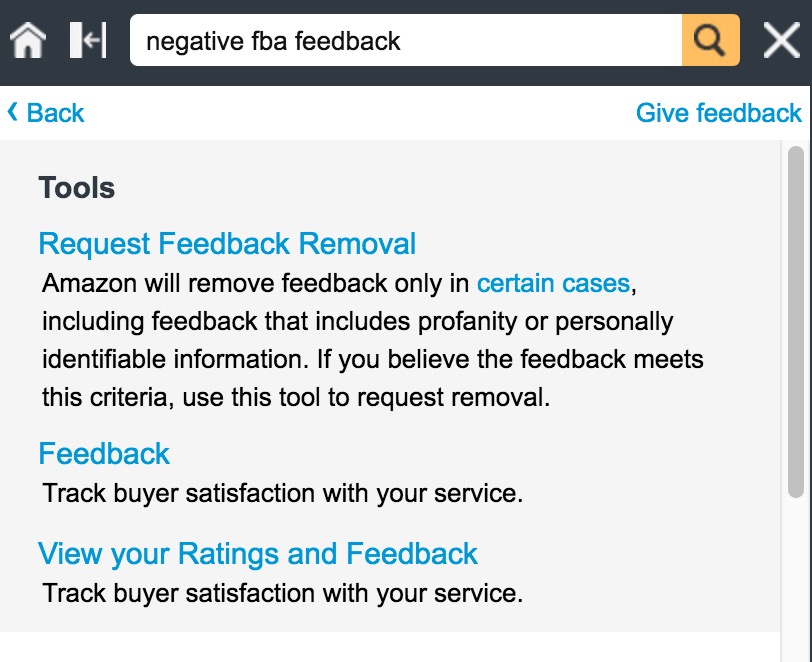Yesterday I wrote about my first ever negative FBA feedback received by selling through Amazon. This was related to an Apple watch purportedly received with an empty box (no watch inside). Since this was sold fulfilled by Amazon, I thought it was a bit unfair to get negative FBA feedback about something that I had no control over! After reading up on things, there’s a fairly easy way to get negative FBA feedback removed (assuming you have a valid case like this)
Get negative FBA feedback removed through the FBA Help section
The first step to get negative FBA feedback removed is to go into the Seller Support section in Amazon Seller Central. The way I got to the negative FBA feedback screen is to go to the Help screen and search for ‘negative FBA feedback’

Clicking the Request Feedback Removal and choose Customers and Orders and put in the Order ID of the order with the negative FBA feedback. Amazon Seller Central prepopulates the page with your most recent 3-5 orders, but in my case the Order ID was not any of those, so I just found the order that had the negative feedback and pasted it in.
I submitted my negative feedback removal request and automatically received a message saying

All right! That’s what I’m talking about. If you don’t get an automatic success message like this one, you will have to wait for Amazon to manually review your negative FBA feedback removal request. This should happen within a few days, or if not, you can always open up a ticket with Amazon Seller Support.
Negative FBA feedback removal – success!
Immediately after getting that message, I went back into Amazon FBA Seller Central to check my feedback. I can now see my feedback, and the negative FBA feedback was instantly removed! It’s listed there for historical references but it’s struck-through and Amazon has a comment owning the negative feedback.

Thanks Amazon, for taking responsibility for the fulfillment experience!
This site is part of an affiliate sales network and receives compensation for sending traffic to partner sites, such as thepointsguy.com. This may impact how and where links appear on this site. Responses are not provided or commissioned by the bank advertiser. Some or all of the card offers that appear on the website are from advertisers and that compensation may impact on how and where card products appear on the site. Any opinions expressed in this post are my own, and have not been reviewed, approved, or endorsed by my advertising partners and I do not include all card companies, or all available card offers. Terms apply to American Express benefits and offers and other offers and benefits listed on this page. Enrollment may be required for select American Express benefits and offers. Visit americanexpress.com to learn more. Other links on this page may also pay me a commission - as always, thanks for your support if you use them


 Dan Miller travels with his wife and 6 (SIX!) children. He loves to help families travel for free / cheap, especially larger families. If you are looking for help, drop him an email at
Dan Miller travels with his wife and 6 (SIX!) children. He loves to help families travel for free / cheap, especially larger families. If you are looking for help, drop him an email at 
I’ve spent 15 years developing an eBay “business” (hobby) and have high-value inventory – primarily software. With my family is growing, I am struggling to manage it all and am considering transitioning to FBA.
2 questions I have related to this post:
1) I am assuming as an MS process, you are working with fairly narrow margins. Broadly, how did this event impact your equation? What I’m getting at is that eBay seems like a much safer selling environment with protections in place to discourage buyer fraud, whereas Amazon appears to just say “Ok” to every buyer claim. Am I seeing this risk clearly, and how much of a factor do you feel it is in your experience?
2) Is there a penalty or added cost for long-term FBA? As an example, I have several items that are selling for ~$50 now, but as supply dries up and scarcity sets in I anticipate the value rising to $150 within the next year. Would Amazon allow me to list via FBA with a price of $150 and be willing to sit on that inventory for 18 months while the market price rises to meet my selling price? Or are there fees and restrictions in place that would block this strategy?
My over-arching fear, of course, is that someone buys my “one of a kind” item for $1,000, receives it, claims it was a fake, and returns some bogus item instead – effectively allowing them to keep the real thing in their collection and leaving me with nothing for the years of work and speculation that allowed me to acquire this highly-desirable item. Thanks for hearing me out and any feedback you can provide on the process
I was able to get the negative FBA feedback removed with no problem and I don’t think it should have any long-term affect on my FBA. I believe there ARE storage fees that are assessed at some point but I personally haven’t run into them